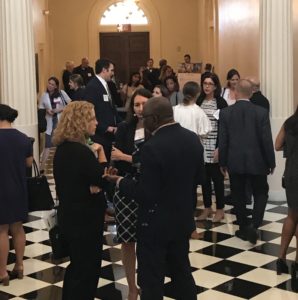It is with a deep sense of gratitude that I thank all of the attendees, organizers, panelists, presenters and sponsors who supported the 2018 Medtech Women @ SEMDA event earlier this month in Atlanta. Generating greater diversity in the health care leadership and entrepreneurship to improve the lives of patients, drive economic growth and greater returns for investors is “the mountain we have been assigned to show others that it can be moved,” as Dr. Jayne Morgan, president and dean of the Morehouse School of Medicine eloquently stated.
Together we are building a community to provide female medtech professionals the advice and access desperately needed to address unconscious, but very real, biases. In just one example shared by Dr. Valerie Montgomery Rice, female investigators received 24% of NIH grants in 2002. That number remains disproportionately low at 30% in 2012. On the bright side, females represented 50.7% of U.S. medical school matriculants in 2018.
 Many of those matriculants will generate new science or ideas for novel devices based on clinical experience. They will need our support to help bring those ideas to life-saving utility in the clinical setting to the benefits of all concerned, particularly patients.
Many of those matriculants will generate new science or ideas for novel devices based on clinical experience. They will need our support to help bring those ideas to life-saving utility in the clinical setting to the benefits of all concerned, particularly patients.
“Your brand is not yours to keep bottled up,” Dr. Montgomery Rice said. Women in health care leadership positions need to advocate, allow others to tell our stories, serve on boards of directors, have an opinion and be open to sharing it.
Panel discussion pearls:
- “Overestimating their valuation is a black mark on an entrepreneur’s resume,” said Paul Gianneschi. “If they don’t understand valuation, what else don’t they understand?”
- “[Too many entrepreneurs] think all capital is equal,” said Bob Crutchfield. There is a significant difference in capital thesis and approaches to investing among large venture funds, institutional investors, growth stage investors and seed round investors. “Spend more time understanding the stage you’re in, the capital needed to achieve the next inflection point and match that to investors’ unique theses.”
- “Understanding your reimbursement pathway is so important,” said Ashley Wittorf. Fewer and fewer doctors are responsible for purchasing decisions. “The old ways of doing things in devices don’t work any more.”
- “Bringing items in [to the hospital] and taking them out is an easier sell. We can’t continuously bring items in and in and in. What we may be able to get rid of is one of our first questions [to an innovator or supplier].”
- “Be open when people are trying to help you,” said Lori Chmura. “Recognize the shiny object: when to chase and when not to. Don’t underestimate the value of analytics especially regarding valuations and trajectory.”
- “Disruptive [new] technology is collaborative. We need tech to talk to us better. One particular filter could not inform someone else about the damage it was causing.” – Janice Newsome
 Denise Hines, CEO of the Georgia Health Information Network, encouraged us all to reach up, reach out and reach down. Reach up to your mentors. Create and maintain your own network of trusted advisors. Reach out to your community including professional organizations [like MW@S] for network and leadership skills development. Reach down to help others. “Once you have reached a certain position, you are obligated to help others,” she said. Provide references, job leads and event attendance sponsorships are just a few ways you can do that. You may have as much fun learning from young professionals as a mentor as you deliver value in your mentoring and assisting.
Denise Hines, CEO of the Georgia Health Information Network, encouraged us all to reach up, reach out and reach down. Reach up to your mentors. Create and maintain your own network of trusted advisors. Reach out to your community including professional organizations [like MW@S] for network and leadership skills development. Reach down to help others. “Once you have reached a certain position, you are obligated to help others,” she said. Provide references, job leads and event attendance sponsorships are just a few ways you can do that. You may have as much fun learning from young professionals as a mentor as you deliver value in your mentoring and assisting.
If you weren’t able to join us, you can find the upcoming MW@S events, including webinars and an onsite event in Memphis on November 7, 2018, here.
Nominations are also now open for the second class of the Top 10 Women in Southeast Medtech. I encourage you to nominate one of your colleagues.
I also encourage you to keep up with the latest from our teams via LinkedIn and Twitter.
GCMI on LinkedIn
GCMI on Twitter
SEMDA on LinkedIn
SEMDA on Twitter
Sincerely,
Tif
